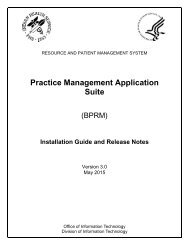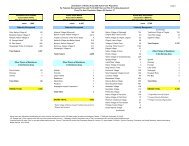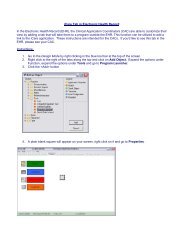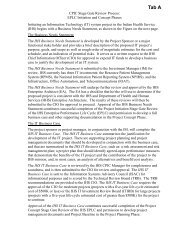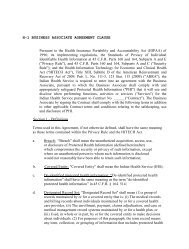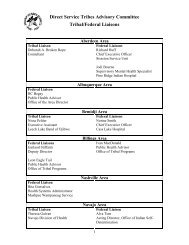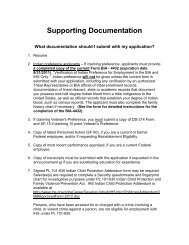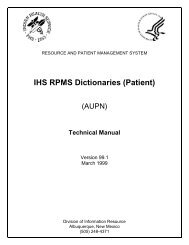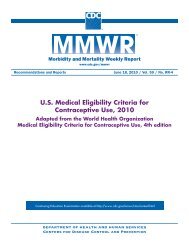What's New in Diabetic Neuropathy?
What's New in Diabetic Neuropathy?
What's New in Diabetic Neuropathy?
Create successful ePaper yourself
Turn your PDF publications into a flip-book with our unique Google optimized e-Paper software.
What’s <strong>New</strong> <strong>in</strong> <strong>Diabetic</strong><br />
<strong>Neuropathy</strong>?<br />
Jill Kimm, MD<br />
Jill.kimm@kdmc.net 606-694-0031<br />
Ashland, Kentucky<br />
August, 2011
WWW.IHS.GOV<br />
• MEDICAL PROGRAMS<br />
• DIVISION OF DIABETES AND PREVENTION<br />
• DM2 DIABETES AND NEUROPATHY<br />
• Quick Guide Cards<br />
• DM Treatment Algorithms<br />
• DIABETES CARE 2011; 34 (supplement 1)<br />
• NEUROLOGY prepublished onl<strong>in</strong>e April 11, 2011<br />
• JAMA 2009; 302(13): 1451-1458.<br />
Presented by IHS Division of Diabetes<br />
2
*<br />
Presented by IHS Division of Diabetes<br />
3
Case Presentation<br />
• 60 year old R handed NA man with a ten year history of<br />
DM II. His A1c falls between 9 and 10. He adheres to<br />
medication regimes but has trouble stick<strong>in</strong>g to diet and<br />
exercise recommendations. He has never mentioned nerve<br />
pa<strong>in</strong> or numbness until you ask him at his annual visit.<br />
• About 5 years ago he began to note stabb<strong>in</strong>g pa<strong>in</strong>s <strong>in</strong> all<br />
toes. He noted some woody numbness of both feet and<br />
imbalance on uneven surfaces. Numbness has migrated to<br />
mid-sh<strong>in</strong>s. The pa<strong>in</strong> has progressed and become<br />
bothersome. He feels like he is walk<strong>in</strong>g on broken glass.<br />
His feet burn at night, and the touch of the sheets feels<br />
pa<strong>in</strong>ful. He th<strong>in</strong>ks he has bad circulation.<br />
Presented by IHS Division of Diabetes<br />
4
Case Presentation<br />
• PMH: HTN, hyperlipidemia<br />
• PSH: bunionectomy<br />
• P+SH: no drugs, EtOH<br />
• FMH: DM<br />
• Meds: lis<strong>in</strong>opril, metform<strong>in</strong>, Lantus<br />
• ROS: He admits dizz<strong>in</strong>ess, erectile dysfunction,<br />
constipation, nocturnal diarrhea, weight ga<strong>in</strong><br />
Presented by IHS Division of Diabetes<br />
5
Case Presentation: Exam<br />
• BP ly<strong>in</strong>g 120/80 sitt<strong>in</strong>g 110/80 stand<strong>in</strong>g 80/64.<br />
• P 100 R 12 T 98.4 W 295 lb.<br />
• Heart, lungs, neck, normal. Extremities hairless with dry,<br />
callused sk<strong>in</strong> of feet, pulses <strong>in</strong>tact.<br />
• MS – normal.<br />
• CN II-XII - normal aside from miotic pupils.<br />
• Motor – 4+/5 dorsiflexion of great toe .<br />
• Sense – decreased PP and cold sensation to knees. Absent<br />
vibration perception to mid-sh<strong>in</strong>.<br />
• CBM – tandem poor, casual normal, cannot walk on heels .<br />
• DTRs – BRJ 1/1 BJ 1/1 TJ 1/1 KJ tr/tr AJ 0/0.<br />
Presented by IHS Division of Diabetes<br />
6
Th<strong>in</strong>k<strong>in</strong>g<br />
• Classic presentation for chronic, long stand<strong>in</strong>g<br />
diabetic neuropathy with sensorimotor <strong>in</strong>volvement,<br />
one of the microvascular complications.<br />
• People associate numbness, but not pa<strong>in</strong>, with<br />
neuropathy, th<strong>in</strong>k “bad circulation.” This is chronic<br />
already.<br />
• He likely has autonomic neuropathy.<br />
Presented by IHS Division of Diabetes<br />
7
ADA Def<strong>in</strong>ition, Recommendations<br />
• Symmetrical, length-dependent sensorimotor<br />
polyneuropathy attributable to metabolic and<br />
microvessel alterations as a result of chronic<br />
hyperglycemia exposure and cardiovascular risk<br />
covariates. -Diabetes Care 33: 2285-2293, 2010<br />
• Screen at diagnosis and yearly for DPN us<strong>in</strong>g simple<br />
tests. EP studies are rarely necessary.<br />
• Screen for autonomic neuropathy.<br />
• Medications improve quality of life.<br />
- Diabetes Care 34 (supplement 1): S8, 2011.<br />
Presented by IHS Division of Diabetes<br />
8
<strong>Diabetic</strong> Neuropathies<br />
Focal/Multifocal Polyneuropathy<br />
• Mononeuropathy<br />
• Median<br />
• Ulnar >>> Radial<br />
• Multiple lesions “mononeuritis<br />
multiplex” RARE<br />
• Amyotrophy, proximal motor<br />
neuropathy<br />
• Deep, burn<strong>in</strong>g thigh pa<strong>in</strong><br />
• Progressive, asymmetric<br />
proximal weakness<br />
• Marked quadriceps wast<strong>in</strong>g &<br />
absent knee jerk(s)<br />
Presented by IHS Division of Diabetes<br />
• <strong>Diabetic</strong> peripheral neuropathy,<br />
polyneuropathy, sensorimotor<br />
neuropathy<br />
• Acute sensory neuropathy<br />
• Very poor control or DKA, rapid<br />
glycemic control, or weight loss<br />
• Small fiber, normal exam<br />
• Resolves <strong>in</strong> a year<br />
• Autonomic neuropathy<br />
• Orthostatic hypotension<br />
• Gastroparesis, constipation,<br />
nocturnal diarrhea<br />
• Bladder hypomotility<br />
• Sexual dysfunction<br />
• Sudomotor and pupil abnormalities<br />
9
<strong>Diabetic</strong> <strong>Neuropathy</strong><br />
• Most common (90%) is DSMPN, DPN<br />
• Symmetric, length-dependent <strong>in</strong>jury to peripheral<br />
nerves<br />
• Axonal<br />
• 16% -60% of diabetics; half have pa<strong>in</strong><br />
• Frequently untreated (40%)<br />
• A microvascular complication, like kidney and ret<strong>in</strong>a<br />
• Pivotal component of foot disease and morbidity<br />
Presented by IHS Division of Diabetes<br />
10
Classic Symptoms<br />
• Pa<strong>in</strong> worsens at night and improves with walk<strong>in</strong>g<br />
• Ach<strong>in</strong>g, lanc<strong>in</strong>ation, burn<strong>in</strong>g<br />
• Location 96% feet, 69% balls of feet, 67% toes, 54%<br />
dorsal feet, 37% plantar feet, 39% hands, 37% calves,<br />
32% heels<br />
• Allodynia<br />
• Hyperalgesia, hyperpathia<br />
• Numbness<br />
• Paresthesia, dysesthesia<br />
Presented by IHS Division of Diabetes<br />
11
Red Flags – Wrong Diagnosis<br />
• Pronounced asymmetry<br />
• Predom<strong>in</strong>ant motor deficits, one nerve or one root,<br />
cranial neuropathy<br />
• Pa<strong>in</strong> with walk<strong>in</strong>g relieved by rest<br />
• Rapid progression despite ideal control<br />
• Symptoms and deficits <strong>in</strong> arms only<br />
• Family history non-diabetic neuropathy<br />
• Cannot confirm diagnosis by exam (good reflexes and<br />
vibration perception, e.g.)<br />
• Labs: TSH, B12, SPIEP, RPR<br />
Presented by IHS Division of Diabetes<br />
12
Patient Education<br />
• A condition that can develop <strong>in</strong> diabetics.<br />
• High blood sugar can cause nerve damage <strong>in</strong> feet and legs. The<br />
damage slows down nerve signals to the muscles and sk<strong>in</strong>. It can<br />
cause the nerves to send wrong signals at wrong times, which<br />
can cause pa<strong>in</strong>. Sometimes the nerves can stop communicat<strong>in</strong>g<br />
completely, and that can lead to numbness and weakness.<br />
• People with neuropathy have many symptoms. Some people<br />
already have nerve symptoms when DM is diagnosed. Symptoms<br />
tend to develop slowly over years.<br />
• The nerves and organs that control automatic body processes<br />
may be hurt by diabetes. Some people develop dizz<strong>in</strong>ess on<br />
stand<strong>in</strong>g. Sweat<strong>in</strong>g may <strong>in</strong>crease or decrease. Upset stomach,<br />
constipation, and nighttime diarrhea may occur. Bladder control<br />
and sexual function may be bothered. This is called autonomic<br />
neuropathy.<br />
Presented by IHS Division of Diabetes<br />
13
<strong>Diabetic</strong> <strong>Neuropathy</strong> Symptom Score<br />
• Are you experienc<strong>in</strong>g unstead<strong>in</strong>ess <strong>in</strong> walk<strong>in</strong>g?<br />
• Do you have burn<strong>in</strong>g or ach<strong>in</strong>g of feet or legs?<br />
• Do you have prickl<strong>in</strong>g sensations of feet or legs?<br />
• Do you have numbness of feet or legs?<br />
SCORE<br />
0=No DPN 1-4=PN<br />
Reliability 0.64; Sensitivity 79%; Specificity 78%<br />
Presented by IHS Division of Diabetes<br />
14
Michigan <strong>Neuropathy</strong> Screen<strong>in</strong>g<br />
Instrument – A. History<br />
1. Are your legs and/or feet (LAOF)<br />
numb?<br />
2. Do you ever have any burn<strong>in</strong>g pa<strong>in</strong><br />
<strong>in</strong> LAOF?<br />
3. Are your feet too sensitive to touch?<br />
4. Do you get muscle cramps <strong>in</strong> LAOF?<br />
5. Do you ever have any prickl<strong>in</strong>g<br />
feel<strong>in</strong>gs <strong>in</strong> your LAOF?<br />
6. Does it hurt when the bed covers<br />
touch your sk<strong>in</strong>?<br />
7. When you get <strong>in</strong>to tub or shower, are<br />
you able to tell hot water from cold<br />
water?<br />
Presented by IHS Division of Diabetes<br />
8. Have you ever had open sore on<br />
foot?<br />
9. Has your doctor ever told you that<br />
you have diabetic neuropathy?<br />
10. Do you feel weak all over most of the<br />
time?<br />
11. Are your symptoms worse at night?<br />
12. Do your legs hurt when you walk?<br />
13. Are you able to sense your feet when<br />
you walk?<br />
14. Is the sk<strong>in</strong> on your feet so dry that it<br />
cracks open?<br />
15. Have you ever had an amputation?<br />
15
MNSI - History<br />
• For pr<strong>in</strong>table forms:<br />
http://www.med.umich.edu/mdrtc/profs/survey.html<br />
#mnsi<br />
• Self adm<strong>in</strong>istered by patient<br />
• Score “Yes” to 1-3, 5-6, 8-9, 11-12, 14-15 one po<strong>in</strong>t each<br />
• Score “No” for 7 and 13 as 1 po<strong>in</strong>t each<br />
• #4 is a measure of impaired circulation and #10<br />
general asthenia, no po<strong>in</strong>ts<br />
• Max history score = 13<br />
Presented by IHS Division of Diabetes<br />
16
MNSI - Physical<br />
TEN POINTS<br />
MAX<br />
0 POINT FOR<br />
EACH SIDE<br />
Presented by IHS Division of Diabetes<br />
0.5 POINT FOR<br />
EACH SIDE<br />
1 POINT FOR<br />
EACH SIDE<br />
17
MNSI - Appearance<br />
• Inspect for excessively dry sk<strong>in</strong>, callus, fissures,<br />
ulceration, or deformities<br />
• Deformities <strong>in</strong>clude flat feet, hammer toes,<br />
overlapp<strong>in</strong>g toes, claw toes, hallux valgus, jo<strong>in</strong>t<br />
subluxation, prom<strong>in</strong>ent metatarsal heads, medial<br />
convexity (Charcot), and amputation.<br />
Presented by IHS Division of Diabetes<br />
18
Charcot<br />
Presented by IHS Division of Diabetes<br />
19
Jo<strong>in</strong>t Abnormalities<br />
Presented by IHS Division of Diabetes<br />
20
Sk<strong>in</strong> Abnormalities<br />
Presented by IHS Division of Diabetes<br />
21
MNSI - Vibration<br />
• Test bilaterally us<strong>in</strong>g 128 hz tun<strong>in</strong>g fork over dorsum<br />
great toe bony prom<strong>in</strong>ence of DIP<br />
• Exam<strong>in</strong>er can feel for 5 sec longer than normal subject<br />
on great toe. Most can feel for 12 sec.<br />
• Own f<strong>in</strong>ger < 10 sec, present<br />
• Reduced if own f<strong>in</strong>ger > 10 sec<br />
• Absent if no vibration perception<br />
Presented by IHS Division of Diabetes<br />
22
Tun<strong>in</strong>g Fork<br />
for Your Entire Sensory Exam<br />
Presented by IHS Division of Diabetes<br />
23
MNSI - Ankle Reflexes<br />
• Sitt<strong>in</strong>g position, foot dependent, pt relaxed<br />
F Foot relaxed and slightly dorsiflexed<br />
Achilles percussed directly<br />
• Reflex present<br />
• Reflex present with Jendrassic maneuver<br />
• Reflex absent with Jendrassic<br />
re<strong>in</strong>forcement<br />
Presented by IHS Division of Diabetes<br />
24
MNSI - Monofilament<br />
• Foot supported; eyes closed<br />
• Pre-stress 10 gm monofilament with 4-6 perpendicular<br />
applications to dorsum of f<strong>in</strong>ger<br />
• Apply perpendicular to po<strong>in</strong>t of bend<strong>in</strong>g for 1 sec, release<br />
• Apply to dorsum of great toe between nail fold and DIP for<br />
1 sec, even pressure, 10 times: 8/10 normal; 1-7 reduced;0 absent<br />
• IHS/ADA: Apply to plantar great toe and 1,3,5 metatarsal heads<br />
• Even one site <strong>in</strong>sensate is high risk foot<br />
• 2011 ADA recommends test<strong>in</strong>g vibration, p<strong>in</strong>prick, or ankle<br />
jerks<br />
- (Diabetes Care 2011: 34 (supplement 1): S37.)<br />
Presented by IHS Division of Diabetes<br />
25
IHS - Monofilament<br />
Presented by IHS Division of Diabetes<br />
26
Treatment<br />
• Glycemic control and correction of metabolic<br />
derangements should be first.<br />
• Pa<strong>in</strong> is difficult to treat and treatment is frustrat<strong>in</strong>g.<br />
Help establish realistic goals.<br />
• Negative sensory symptoms are not symptomatically<br />
treatable. Weakness is not treatable.<br />
Presented by IHS Division of Diabetes<br />
27
Education<br />
• Look at your feet daily and check for cuts, blisters, redness,<br />
nail problems.<br />
• Wash <strong>in</strong> lukewarm (not hot) water, and check temperature<br />
with your elbow first.<br />
• Dry your feet by blott<strong>in</strong>g, especially between toes.<br />
• Moisturize daily with Vasel<strong>in</strong>e® or Crisco®, not between<br />
toes.<br />
• Wear shoes that fit well, have support, and room for toes.<br />
• Shake your shoes and look <strong>in</strong>side before wear<strong>in</strong>g them.<br />
• Keep your feet warm and dry, especially <strong>in</strong> w<strong>in</strong>ter.<br />
Presented by IHS Division of Diabetes<br />
28
Education 2<br />
• Wear clean, dry, soft socks and change daily.<br />
• Never walk barefoot, even at home.<br />
• Cut nails carefully and straight across.<br />
• Never trim corns or calluses.<br />
• Smok<strong>in</strong>g cigarettes will make you worse by cutt<strong>in</strong>g<br />
oxygen to nerves.<br />
• Dr<strong>in</strong>k<strong>in</strong>g alcohol is poisonous to nerves.<br />
• Cross<strong>in</strong>g legs should be avoided.<br />
• Moderate walk<strong>in</strong>g <strong>in</strong> well-fitt<strong>in</strong>g shoes is good.<br />
Presented by IHS Division of Diabetes<br />
29
Presented by IHS Division of Diabetes<br />
30
IHS Guidel<strong>in</strong>es 2010<br />
• First L<strong>in</strong>e<br />
• Desipram<strong>in</strong>e<br />
• Amitriptyl<strong>in</strong>e<br />
• Second L<strong>in</strong>e<br />
• Calcium Channel Modulators<br />
• SNRIs<br />
• Third L<strong>in</strong>e<br />
• Long Act<strong>in</strong>g Morph<strong>in</strong>e<br />
• Tramadol<br />
Presented by IHS Division of Diabetes<br />
31
AAN Guidel<strong>in</strong>es 2011<br />
by Strength of Evidence<br />
• STRONG<br />
• Pregabal<strong>in</strong><br />
• MODERATE<br />
• Anticonvulsants – gabapent<strong>in</strong>, valproate<br />
• Amitriptyl<strong>in</strong>e, venlafax<strong>in</strong>e, duloxet<strong>in</strong>e<br />
• Capsaic<strong>in</strong>, isosorbide spray<br />
• Dextromethorphan, morph<strong>in</strong>e, tramadol, oxycodone<br />
• INSUFFICIENT<br />
• Desipram<strong>in</strong>e, imipram<strong>in</strong>e, fluoxet<strong>in</strong>e<br />
• Nortriptyl<strong>in</strong>e and fluphenaz<strong>in</strong>e<br />
• Topiramate<br />
Presented by IHS Division of Diabetes<br />
32
AAN Recommendations<br />
Recommended, <strong>in</strong> mg/day Not recommended<br />
• Pregabal<strong>in</strong>, 300-600 ($150 300 bid)<br />
• Gabapent<strong>in</strong>, 900-3600 ($100)<br />
• Sodium valproate, 500-1200<br />
• Venlafax<strong>in</strong>e, 75-225 ($115)<br />
• Duloxet<strong>in</strong>e, 60-120 ($265)<br />
• Amitriptyl<strong>in</strong>e, 25-100 ($4)<br />
• Dextromethorphan, 400 (!!) (!!)<br />
• Morph<strong>in</strong>e, 10-120<br />
• Tramadol, 100-400 ($100)<br />
• Oxycodone, 10-120 ($220)<br />
• Capsaic<strong>in</strong> 0.075% QID ($20)<br />
• Isosorbide d<strong>in</strong>itrate spray<br />
• Electrical stim 3-4 weeks<br />
Presented by IHS Division of Diabetes<br />
• Oxcarbazep<strong>in</strong>e<br />
• Lamotrig<strong>in</strong>e<br />
• Lacosamide<br />
• Clonid<strong>in</strong>e<br />
• Pentoxifyll<strong>in</strong>e<br />
• Mexilet<strong>in</strong>e<br />
• Magnetic field treatment<br />
• Low-<strong>in</strong>tensity laser<br />
• Reiki therapy<br />
***********************************<br />
• Lidoderm recommended with<br />
m<strong>in</strong>imal evidence ($775)<br />
33
Beware<br />
<strong>New</strong> FDA-approved-for-DPN medications “are likely to<br />
be no better and are considerably more expensive than<br />
older ones.”<br />
Presented by IHS Division of Diabetes<br />
- JAMA 2009; 302 (13): 1451-1458<br />
34
Stepwise Management (IHS, JAMA)<br />
• Assess pa<strong>in</strong> quantitatively<br />
• Identify relevant co-morbidities<br />
• Expla<strong>in</strong> diagnosis and treatment plan and establish realistic<br />
expectations (50% improvement)<br />
• Treat the diabetes<br />
• Titrate first l<strong>in</strong>e to tolerance, effect<br />
• No relief, stop first l<strong>in</strong>e, start second l<strong>in</strong>e<br />
• Partial relief, add second to first<br />
• Third l<strong>in</strong>e last resort and consider add<strong>in</strong>g from other classes<br />
• Give adequate trial at adequate dose (8 wks)<br />
• Try bupropion, topiramate, citalopram, parotex<strong>in</strong>e if all else fails<br />
Presented by IHS Division of Diabetes<br />
35
Remember<br />
• This is chronic disease, and the chronic effects of drug<br />
therapies are unknown. Trials are short.<br />
• No s<strong>in</strong>gle medication has a robust effect on pa<strong>in</strong><br />
• Placebo up to 50% effective<br />
• Effectiveness poor <strong>in</strong> pa<strong>in</strong> (11%) & QOL<br />
• Side effects high<br />
• Cost is high<br />
• Pharmacologic treatment targets pa<strong>in</strong>, not numbness<br />
• Estimated numbers needed to treat (NNT) but not<br />
numbers needed to harm (NNH) available<br />
Presented by IHS Division of Diabetes<br />
36
Effect on Co-morbidities<br />
DULOX-<br />
ETINE<br />
PREGABALIN TRICYCLICS OPIOIDS<br />
DEPRESSION GOOD NEUTRAL GOOD NEUTRAL<br />
OBESITY NEUTRAL BAD NEUTRAL NEUTRAL<br />
ANXIETY GOOD GOOD NA NA<br />
INSOMNIA GOOD GOOD GOOD NA<br />
CAD NEUTRAL NEUTRAL BAD NEUTRAL<br />
AUTONOMIC NA NA BAD BAD<br />
FASTING GLUC BAD SLIGHT NEUTRAL BAD SLIGHT NA<br />
LIVER FAILURE BAD NEUTRAL VARIABLE VARIABLE<br />
RENAL<br />
FAILURE<br />
BAD ADAPTABLE VARIABLE VARIABLE<br />
DRUG-DRUG BAD NEUTRAL BAD NEUTRAL<br />
Presented by IHS Division of Diabetes<br />
37
IHS Flowchart<br />
• TCA if no contra<strong>in</strong>dications<br />
Consider capsaic<strong>in</strong>*<br />
• Pregabal<strong>in</strong> or gabapent<strong>in</strong><br />
Venlafax<strong>in</strong>e or duloxet<strong>in</strong>e<br />
• Opioids<br />
Presented by IHS Division of Diabetes<br />
38
Amitriptyl<strong>in</strong>e<br />
• Check stand<strong>in</strong>g BP before you start. Screen for<br />
autonomic neuropathy. EKG before start.<br />
• NNT 2.1<br />
• Contra<strong>in</strong>dications: CAD, MAOI<br />
• Start at 10-12.5 mg q hs and <strong>in</strong>crease gently to 150 mg q<br />
hs over 6-8 weeks<br />
• SE: orthostatic hypotension, constip, ur<strong>in</strong>ary<br />
retention, arrhythmia, wt ga<strong>in</strong>, OD potential<br />
• Sudden cardiac death<br />
• Weight ga<strong>in</strong><br />
Presented by IHS Division of Diabetes<br />
39
Pregabal<strong>in</strong> (Lyrica©)<br />
• Cost is same no matter size <strong>in</strong> mg. Capsule. NNT 4.2<br />
• Consider titrat<strong>in</strong>g by add<strong>in</strong>g doses <strong>in</strong>stead of<br />
<strong>in</strong>creas<strong>in</strong>g mg per dose.<br />
• Effective dose 100 – 200 mg TID. Start 100 mg qhs and<br />
add morn<strong>in</strong>g dose second week, midday dose third<br />
week. (or 25 –<br />
• 50 tid start, 100 tid second, 150 tid third, 200 tid)<br />
• Serious AE: rhabdomyolysis, ARF, glaucoma<br />
Presented by IHS Division of Diabetes<br />
40
Pregabal<strong>in</strong> (Lyrica©)<br />
• Relative Contra<strong>in</strong>dications: Renal <strong>in</strong>sufficiency<br />
CHF, HTN, Thiazolid<strong>in</strong>edione<br />
• Adverse events: Edema, dizz<strong>in</strong>ess, somnolence, ataxia,<br />
tremor, blurred vision, weight ga<strong>in</strong><br />
• Serious AE: rhabdomyolysis, ARF, glaucoma, <strong>in</strong>crease<br />
PR, thrombocytopenia (all rare), seizure on sudden<br />
withdrawal<br />
• Cl<strong>in</strong>ically significant weight ga<strong>in</strong> (RR 6.2 to placebo)<br />
which <strong>in</strong>creases with duration of use<br />
Presented by IHS Division of Diabetes<br />
41
Gabapent<strong>in</strong><br />
• In head to head trial with amitriptyl<strong>in</strong>e, it lost<br />
• Effective at 900-3600 mg NNT 3.9<br />
• Start 100-300 mg q hs for a week, then bid, then tid,<br />
then 600 tid, then 900 tid.<br />
• Contra<strong>in</strong>dications: severe kidney disease<br />
• Few d-d <strong>in</strong>teractions and no hepatic metabolism<br />
• Side effects somnolence, dizz<strong>in</strong>ess, ataxia, nausea, dry<br />
mouth, constipation, leukopenia, weight ga<strong>in</strong><br />
Presented by IHS Division of Diabetes<br />
42
Topiramate (Topamax©)<br />
• AAN: <strong>in</strong>sufficient evidence to support<br />
• Topiramate may cause marked weight loss. One study<br />
shows additive effectiveness with opiates.<br />
• If you use opiates, consider addition.<br />
• Start at 25 mg hs and titrate to 100 mg over 3 week.<br />
• SE: paresthesias (banana), cognitive dysfunction, rare<br />
kidney stone, heat exhaustion so push fluids<br />
Presented by IHS Division of Diabetes<br />
43
Sodium Valproate (Depakote©)<br />
• Although sodium valproate may be effective <strong>in</strong> treat<strong>in</strong>g<br />
PDN, it is potentially teratogenic and should be avoided<br />
<strong>in</strong> diabetic women of childbear<strong>in</strong>g age. Due to potential<br />
adverse effects such as weight ga<strong>in</strong> and potential<br />
worsen<strong>in</strong>g of glycemic control, this drug is unlikely to be<br />
the first treatment choice for PDN.<br />
• You will probably regret us<strong>in</strong>g valproate <strong>in</strong><br />
diabetics. If you do, add folate 1 mg q day and check<br />
CBC, AST<br />
Presented by IHS Division of Diabetes<br />
44
Venlafax<strong>in</strong>e (Effexor ©)<br />
• 75-225 mg daily (tid or XR daily) NNT 5.5<br />
• Week 1: 37.5, <strong>in</strong>crease over 4 weeks<br />
• Contra<strong>in</strong>dications: 14 days of MAO, tramadol, CAD<br />
• SE: HA, nausea, sedation, constipation, diarrhea,<br />
HTN, seizures. Rare: SIADH<br />
• Monitor BP, cholesterol, HR<br />
• Add gabapent<strong>in</strong>, taper slowly once established<br />
Presented by IHS Division of Diabetes<br />
45
Duloxet<strong>in</strong>e (Cymbalta©)<br />
• 60 -120 mg daily, start at 30-60; NNT 4<br />
• Contra<strong>in</strong>dications: any liver dysfunction, EtOH,<br />
CrCl
Opioids<br />
• Dextromethorphan 400 mg dose and 58% dropped<br />
out. Robituss<strong>in</strong> caps 15 mg qid reasonable. Do not<br />
comb<strong>in</strong>e w SSRI or opiates.<br />
• Tramadol<br />
• Morph<strong>in</strong>e<br />
• Oxycodone<br />
• Consider comb<strong>in</strong><strong>in</strong>g with gabapent<strong>in</strong><br />
Presented by IHS Division of Diabetes<br />
47
Opioids<br />
• The use of opioids for chronic nonmalignant pa<strong>in</strong> has ga<strong>in</strong>ed credence<br />
over the last decade due to the studies reviewed <strong>in</strong> this article.<br />
• Both tramadol and dextromethorphan were associated with substantial<br />
adverse events (e.g., sedation <strong>in</strong> 18% on tramadol and 58% on<br />
dextromethorphan, nausea <strong>in</strong> 23% on tramadol, and constipation <strong>in</strong><br />
21% on tramadol).<br />
• The use of opioids can be associated with the development of novel<br />
pa<strong>in</strong> syndromes such as rebound headache and hyperpathia.<br />
• Chronic use of opioids leads to tolerance and frequent escalation of<br />
dose.<br />
• Side effects: hyperpathia, hypogonadism, weight ga<strong>in</strong>,<br />
constipation, death from drug-drug <strong>in</strong>teractions. Expla<strong>in</strong> <strong>in</strong><br />
patient medication agreement along with guidel<strong>in</strong>es for safe use.<br />
Presented by IHS Division of Diabetes<br />
48
Capsaic<strong>in</strong>, Isosorbide, Lidoderm©<br />
• Although capsaic<strong>in</strong> has been effective <strong>in</strong> reduc<strong>in</strong>g pa<strong>in</strong> <strong>in</strong> PDN cl<strong>in</strong>ical<br />
trials, many patients are <strong>in</strong>tolerant of the side effects, ma<strong>in</strong>ly burn<strong>in</strong>g<br />
pa<strong>in</strong> on contact with warm/hot water or <strong>in</strong> hot weather.<br />
• It may take 8 weeks to work, as it works by deplet<strong>in</strong>g Substance P,<br />
and few are that patient.<br />
• Intolerance will develop rapidly, so have patient buy smallest size.<br />
Wash hands after application.<br />
• Isosorbide d<strong>in</strong>itrate spray (Isocard©) 30 mg per actuation. 1 spray to<br />
each foot at bedtime. Contra<strong>in</strong>dicated with NTG spray and with<br />
sildenafil and similar.<br />
• SE: headache, dizz<strong>in</strong>ess<br />
• Lidoderm© patches have scant evidence. Up to 3 patches can be<br />
applied to feet and ankles, 12 hours on, 12 hours off. Must be disposed<br />
of <strong>in</strong> sealed conta<strong>in</strong>er.<br />
Presented by IHS Division of Diabetes<br />
49
Others<br />
• Alpha-lipoic acid 600 mg daily may treat neuropathy and<br />
pa<strong>in</strong> (*AAN says <strong>in</strong>sufficient)<br />
• Percutaneous nerve stimulation (AAN effective) 30 m<strong>in</strong>s 3<br />
times a week (TENS 30 m<strong>in</strong> daily)<br />
• Oil of even<strong>in</strong>g primrose (omega 6/gamma l<strong>in</strong>olenic acid)<br />
360 – 480 mg daily; SE: bleed<strong>in</strong>g, seizure (***)<br />
• Borage seed or oil omega 6 also (***)<br />
• Carnit<strong>in</strong>e/CoE Q10 (***)<br />
• Topical pepperm<strong>in</strong>t oil may be cool<strong>in</strong>g and sooth<strong>in</strong>g (***).<br />
Presented by IHS Division of Diabetes<br />
***= anecdotal<br />
50
Autonomic <strong>Neuropathy</strong><br />
• Orthostatic hypotension: Jobst stock<strong>in</strong>gs, elevate HOB,<br />
small meals, salt, fludrocortisone, midodr<strong>in</strong>e<br />
• Gastroparesis: metoclopramide, erythromyc<strong>in</strong>, odansetron,<br />
promethaz<strong>in</strong>e, botul<strong>in</strong>um tox<strong>in</strong> to pylorus, gastric pac<strong>in</strong>g<br />
• Nocturnal diarrhea: trial of metronidazole or<br />
cephalospor<strong>in</strong>, loperamide 2-4 mg qid, diphenoxylate &<br />
atrop<strong>in</strong>e 2 tabs qid, code<strong>in</strong>e 30 mg qid, clonid<strong>in</strong>e 0.1 mg at<br />
hs, trial of prok<strong>in</strong>etic agents<br />
• Constipation: fiber <strong>in</strong> diet, exercise, usual agents<br />
• Bladder hypomobility: Valsalva, Crede, bethanechol <strong>in</strong><br />
extreme cases<br />
Presented by IHS Division of Diabetes<br />
51
Thank you<br />
• Questions?<br />
• Email jill.kimm@kdmc.net for slides.<br />
Presented by IHS Division of Diabetes<br />
52



